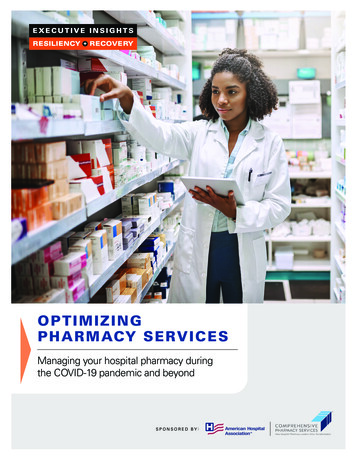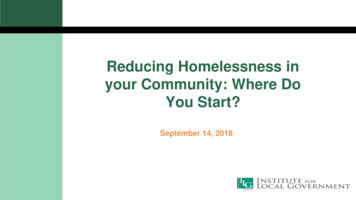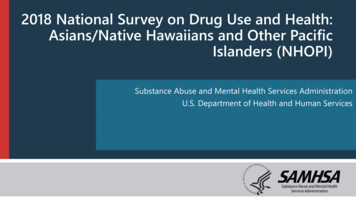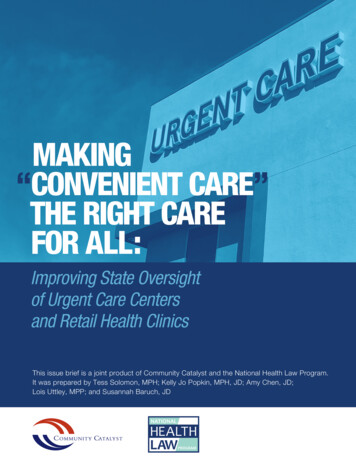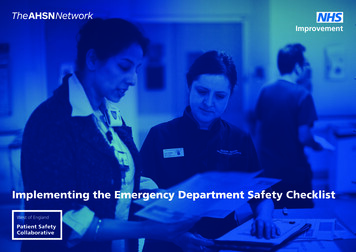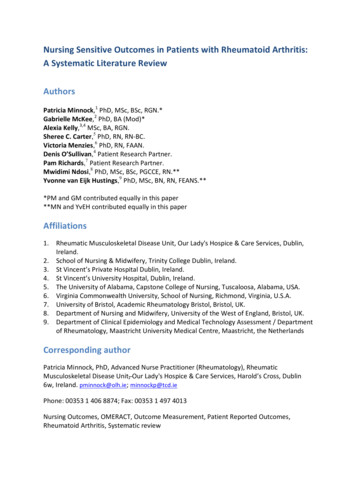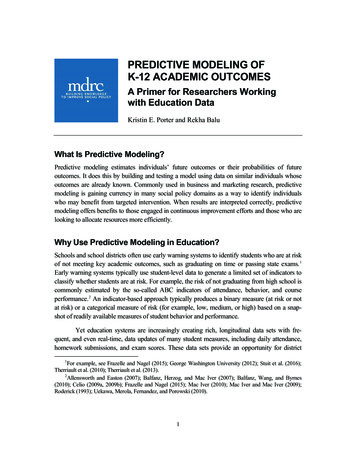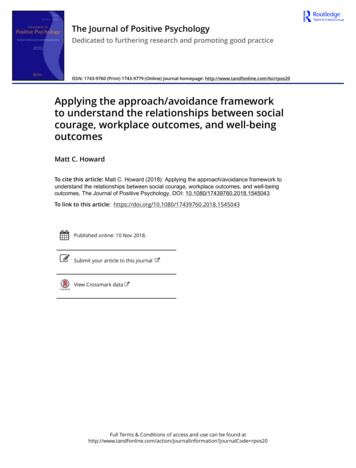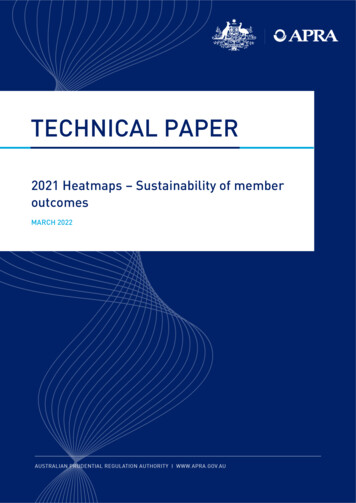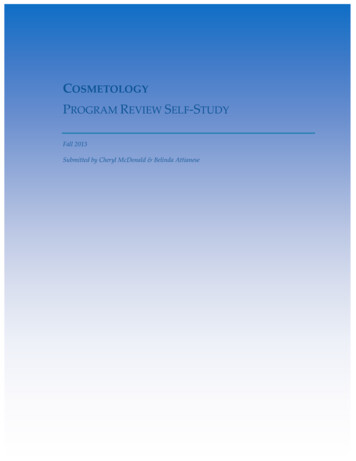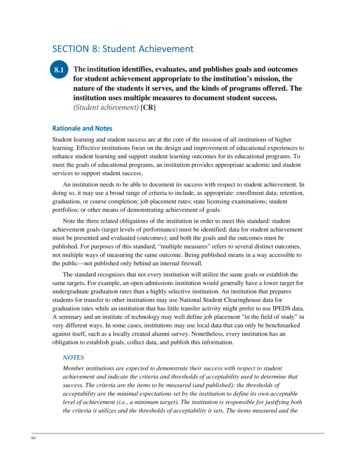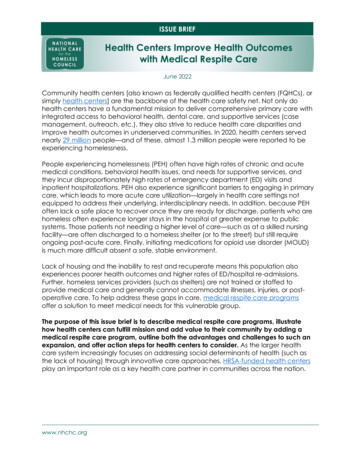
Transcription
ISSUE BRIEFHealth Centers Improve Health Outcomeswith Medical Respite CareJune 2022Community health centers [also known as federally qualified health centers (FQHCs), orsimply health centers] are the backbone of the health care safety net. Not only dohealth centers have a fundamental mission to deliver comprehensive primary care withintegrated access to behavioral health, dental care, and supportive services (casemanagement, outreach, etc.), they also strive to reduce health care disparities andimprove health outcomes in underserved communities. In 2020, health centers servednearly 29 million people—and of these, almost 1.3 million people were reported to beexperiencing homelessness.People experiencing homelessness (PEH) often have high rates of chronic and acutemedical conditions, behavioral health issues, and needs for supportive services, andthey incur disproportionately high rates of emergency department (ED) visits andinpatient hospitalizations. PEH also experience significant barriers to engaging in primarycare, which leads to more acute care utilization—largely in health care settings notequipped to address their underlying, interdisciplinary needs. In addition, because PEHoften lack a safe place to recover once they are ready for discharge, patients who arehomeless often experience longer stays in the hospital at greater expense to publicsystems. Those patients not needing a higher level of care—such as at a skilled nursingfacility—are often discharged to a homeless shelter (or to the street) but still requireongoing post-acute care. Finally, initiating medications for opioid use disorder (MOUD)is much more difficult absent a safe, stable environment.Lack of housing and the inability to rest and recuperate means this population alsoexperiences poorer health outcomes and higher rates of ED/hospital re-admissions.Further, homeless services providers (such as shelters) are not trained or staffed toprovide medical care and generally cannot accommodate illnesses, injuries, or postoperative care. To help address these gaps in care, medical respite care programsoffer a solution to meet medical needs for this vulnerable group.The purpose of this issue brief is to describe medical respite care programs, illustratehow health centers can fulfill mission and add value to their community by adding amedical respite care program, outline both the advantages and challenges to such anexpansion, and offer action steps for health centers to consider. As the larger healthcare system increasingly focuses on addressing social determinants of health (such asthe lack of housing) through innovative care approaches, HRSA-funded health centersplay an important role as a key health care partner in communities across the nation.www.nhchc.org
Health Centers Improve Health Outcomes with Medical Respite CareJune 2022Medical Respite Care (aka Recuperative Care1)Medical Respite CareMedical respite care is also known as “recuperativeProvidespeople experiencingcare.” HRSA defines recuperative care as “short-termhomelessnessa safe space tocare and case management provided to individualsrecuperatefromillness/injuryrecovering from an acute illness or injury that generallypost-hospitalization:does not necessitate hospitalization, but would be Medical care & caseexacerbated by their living conditions (e.g., street,managementshelter or other unsuitable places).” The National Institute Help with documentation &for Medical Respite Care estimates there are 130benefitsmedical respite care programs in the United States Medication & diseaseoperated mostly by small, non-profit organizations (withmanagement skillsonly 36 of these programs operated by a health center). Housing assessments &The most recent assessment of programs found most aresearch preparationsbased in a homeless shelter or a stand-alone facility with Ongoing care planfewer than 20 beds where the median length of stay isdevelopment & care28 days. About half of these programs offer onsitecoordinationclinical services (medical providers, nursing, social work),and nearly all provide supportive services (casemanagement, peer support, etc.). Note that some clinical services could be offeredon-site at a respite program while the majority of care could occur off-site at the healthcenter (or other outpatient venue).The combination of clinical and supportive services together with a short-termresidential component like medical respite care has been shown to reduce ED andhospital re/admissions, improve engagement in care and health outcomes, improvecare coordination and care transitions, and reduce overall system costs. (Find moreinformation about medical respite care here.)Medical respite care programs meet the short-term needs of patients experiencinghomelessness, as well as offer an appropriate, cost-effective solution for both hospitalsand insurers given the lack of safe discharge options. These programs also add value tohealth centers as they engage more vulnerable patients in care.There are different models of medical respite care to consider, and health centers haveoptions in how they incorporate medical respite care. The most common approach isto partner with a homeless shelter and identify a few staff positions to provide casemanagement and/or clinical services to patients at the shelter. Other approachesinvolve different venues for care, as well as varying breadth and depth of servicesoffered and the frequency of service delivery. (The State of Medical Respite Care offersmore information about how programs operate and what services are provided.)Note: ‘recuperative care’ and ‘medical respite care’ are interchangeable terms though ‘recuperativecare’ is the term used in the Public Health Services Act, the authorizing law for health centers.1www.nhchc.org2
Health Centers Improve Health Outcomes with Medical Respite CareJune 2022Advantages to Adding a Medical Respite Care Program to HealthCenter OperationsMedical respite care programs offer five key benefits to health centers:“We include medical respiteMaximizes funding opportunities: Medical respite care hascarein our costs of care and wenot always been well funded or considered reimbursable;bill our PPS rate for everyhowever, there are various funding strategies to explore.encounter. Even with the cost ofHospitals are key financial partners, as are homeless shelters,24-7 nursing staff, we are ablewho can use HUD funding to pay for beds, staffing, andto break even. It’s definitely nota money-loser for us.”other program costs. The rise in value-based payments and Kim Depres, CEO, Circle theaccountable care organizations (ACOs) has also changedCity, Phoenix, AZthe financing landscape. Now, Medicaid and managedcare organizations (MCOs) increasingly cover interventions designed to address socialdeterminants of health—like medical respite care—though health centers in states notexpanding Medicaid to single adults will be more limited on this option. Importantly,health centers may bill at their usual encounter rate for every eligible visit, which cangenerate significant revenue depending on the patient population served. Further,states may allow flexibility for billing nursing care (or other type of staff) if it is fulfilling aphysician-directed medical plan, which can extend reimbursement potential.“There’s a level of acceptancethat we don’t need to focus ontraditional return oninvestment as the only primaryobjective with medical respitebecause of a long-term sharedunderstanding that the serviceprovides other forms of value.” Jordan Wilhelms, Central CityConcern, Portland, ORWhile reimbursement is clearly important, those interviewed forthis brief caution against relying on billable revenue and returnon investment as the sole factors that determine whether ahealth center engages with a medical respite care program.They cite other, non-financial factors that demonstrate howmedical respite care programs add value (which are outlinedbelow), as well as note that health centers should bedetermining services based on patient need rather than earnedrevenue.Adds value for health center as an organization: Medical respite care programs addvalue to health centers because they fulfill mission, going beyond minimum standardsto extend services to a patient population that is chronically marginalized in the healthcare system—and often not engaged in care as a result. The program connectspatients to primary care, behavioral health, support services, and housing (as often aspossible), and staff actively seek to build relationships based on trust and respect. Notonly does this care model bring new patients to the health center, but it also retainsthose patients for ongoing care after the medical respite“FQHCs need to adopt medicalcare stay ends. Importantly, the stability offered throughrespitebecause the populationthe residential component helps improve health centerthey serve needs a differentoutcome measures, such as those foroption to healing that doesn’tvaccines/immunizations, cancer screenings/preventiveexist currently. There has to be acare, control of diabetes and hypertension, andgap-filler, and medical respite isthat filler.”connections to primary/specialty care. For those in ACOs, Miriah Nunnaley, Coloradooutcome measures such as hospital lengths of stay andCoalition for the Homeless,30-day readmission rates are also positively influenced byDenver, COmedical respite care.www.nhchc.org3
Health Centers Improve Health Outcomes with Medical Respite CareJune 2022For health centers who host medical residents (or other clinical roles), medical respitecare programs offer an opportunity to expose students to a social medicine curriculumon rotations and orient them to issues of homelessness earlier in their clinical training.Health centers that are part of public health departments (“public entities”) report aneasier experience collaborating more seamlessly across the entire system, making carecoordination more successful.“We are part of a hospital ACOwith a capitated budget and ashared savings contract—whenthe hospital saves money onlength of stay andre-admissions, we all benefit.” Rhonda Hauff, CEO, YakimaNeighborhood Health Services,Yakima, WAAdds value for the community and to community partners:Interventions that improve the conditions of homelessnessare of high value in any community. Hospitals greatlybenefit from the reduced lengths of stay andre-admissions rates as well as the safe discharge venuesthat medical respite care programs offer them. Homelessservices providers, like shelters, benefit when high-needsclients with health conditions can receive needed care that shelter staff are not trainedor able to provide. Partnerships with homeless shelters are particularly advantageous formedical respite care programs because they can maximize the roles that both partnersplay—with health centers providing staff and services, and shelters providing beds,facilities, and oversight (though this is just one programmatic approach of many).Adds value for clinicians: Medical respite care programs offer clinicians (and the entirecare team) a better way to deliver services, and they experience greater jobsatisfaction as a result. This is especially true if a health center can refer patients directlyto respite (rather than needing a hospital referral). Being able to“As a doc, you get a uniquehave a dedicated space to refer complex patients withperspective from spendingintensive needs so they can stabilize and receive care in a waymore time with patients inthat is not possible in a traditional health center setting isan MRC than a 30-minuteincrediblyrewarding. The extra time to work with patients givesvisit in the clinic allows—youa great opportunity to evaluate functionality and ongoingget a better sense of theirday to day function.”needs, coordinate care, establish a patient relationship, and Sara Jeevanjee, MD,develop a longer-term care plan. Those interviewed for thisValley Homeless Healthcarebriefcite improvements in connecting clients to primary andProgram, Santa Clara, CAbehavioral health care, initiating medications for HIV or opioiduse disorder (MOUD), performing cancer screenings/treatment, as well as havingneeded time to adjust insulin regimens for those with“We treat people with dignitydiabetes. Connecting patients to longer-term treatmentand respect, and often theyprograms and/or permanent housing placements is also verythen say, “I want you to be myfulfilling. Beyond the provision of services, clinicians routinelydoctor.” As a provider, it is veryrewarding to know I’ve earneddescribe greater satisfaction in being able to gain patientsomeone’s trust.”trust, work with a team to deliver holistic care, improve the Tyler Grey, MD, Health Caredismal experience of homelessness (even if temporarily),for the Homeless, Baltimore, MDand see patients improve and become more stable.www.nhchc.org4
Health Centers Improve Health Outcomes with Medical Respite CareJune 2022Adds value to patients: Medical respite care offers the clearest value to patients, whobenefit directly from the services and stability that the program offers them. Not onlyare they able to get their identification and other documentation, but they are able torest and recuperate from their illness or injury, and have time to focus on their care planand next steps instead of needing to prioritize basic needs“Our nurse practitioner wouldsuch as safety and a place to sleep and eat. Medicalget bus tokens and putrespite care programs also offer more autonomy in medicalpatients on the bus so theydecision-makingand engage patients as partners in thecould ride for the day to getoff their feet. MRC solvedprocess, establishing more trust and dignity than is usuallythat, and was a directexperienced in other health care system interactions. Thoseresponse to the expressedhealth centers with Consumer Advisory Boards or thoseneeds and desires of theseeking patient input on needed health centerpatients we serve.”improvements may find that patients experiencing Rhonda Hauff, CEO, YakimaNeighborhood Health Services,homelessness want these types of programs to help themYakima, WAimprove their quality of life.Health Center Requirements: Aligning Medical Respite Care withMission & ComplianceIn order to continue providing comprehensive, culturally competent, high-quality care,health centers are regularly evaluated for compliance with a range of requirementsthat are outlined in HRSA’s Health Center Program Compliance Manual. Theserequirements form the foundation of the Health Center Program and support the coremission of health centers’ innovative and successful model of primary care. Six areas inthe compliance manual most directly align with a medical respite care program (seeTable 1).Table 1. Aligning Medical Respite Care with Health Center RequirementsHealth CenterRequirementHealth Center Program Compliance ManualConnection to Medical Respite CareChapter 3The health center must assess the unmet need forhealth services in the catchment (or proposedcatchment) area of the center based on thepopulation served, with the option to include anadditional focus on a specific underserved subset ofthe service area population.Community needs assessments oftencite a gap in services for peopleexperiencing homelessness whenthey are discharged from hospitalsand/or need a safe place torecuperate from illness/injury.Required andadditionalhealth servicesHealth centers must provide a set of requiredservices. Those services most likely to be delivered ina medical respite care setting include:There is a strong overlap betweencore health center services andmedical respite care services. Whilea number of health centers haveadded ‘recuperative care’ to theirscope of service, several healthcenters interviewed for this issue briefindicated they did not have to addrecuperative care because theapproved list of required servicesNeedsassessmentChapter 4 www.nhchc.orgGeneral primary careScreeningsImmunizationsSubstance use disorder services (for HealthCare for the Homeless grantees only)Case managementEligibility assistanceHealth education5
Health Centers Improve Health Outcomes with Medical Respite CareHealth CenterRequirementHealth Center Program Compliance Manual OutreachTransportationTranslationDetails of the services offered by the health centerare listed on Form 5A as part of a health center’sscope of health center project.Chapter 6Coverage formedicalemergenciesduring and afterhoursConnection to Medical Respite Carealready included the services beingprovided in recuperative care.However, health centers also have the option toadd additional services—with ‘recuperative careservices’ expressly listed as allowable services—"that are appropriate to meet the health needs ofthe population served by the health centerinvolved.” 2Accessiblelocations andhours ofoperationJune 2022For health centers serving a highnumber of patients experiencinghomelessness, medical respite caremay constitute services appropriateto meet patients’ health needs.Note: not all services offered by ahealth center need to be availableat every service site, thereby givingmedical respite care programs moreflexibility to tailor care at a specificlocation.Required services must be available and accessiblein the service area of the health center promptlyand in a manner that ensures continuity of serviceto the residents of the center’s catchment area.Details of a service site are generally included onForm 5B, which lists the details for each approvedservice site, or on Form 5C, which lists other healthcenter activities.Service sites for medical respite carecan be identified as permanent,seasonal, mobile van, or intermittent.Health centers already are required to haveprovisions for promptly responding to patientmedical emergencies during the health center’sregularly scheduled hours, as well as arrangementsfor responding after hours.Medical respite care programs offeran additional route to providing 24/7coverage for particularly vulnerablepatients.Health centers must provide the required primaryhealth services of the center promptly and in amanner that will assure continuity of service topatients within the center's catchment area (servicearea), as well as develop an ongoing referralrelationship with one or more hospitals.Medical respite care programs oftenare based on contracting withpartner hospitals so there is a safedischarge option for patients, andan expressed goal to improvecoordination of care.Health centers must make every reasonable effortto establish and maintain collaborative relationshipswith other health care providers in the service area,local hospitals, and specialty providers. They arealso required to provide access to services notavailable through the health center and to reducethe non-urgent use of hospital emergencydepartments.Medical respite care programsspecifically fulfil this requirementgiven their ability to reduce ED visits,extend needed service provision toa vulnerable group, and establishrelationships with area hospitals (andother types of providers who mightrefer to the program).Chapter 7Continuity ofcare andhospitaladmittingChapter 8CollaborativeRelationshipChapter 142Note: ‘recuperative care’ and ‘medical respite care’ are interchangeable terms though ‘recuperativecare’ is the term used in the Public Health Services Act, the authorizing law for health centers.www.nhchc.org6
Health Centers Improve Health Outcomes with Medical Respite CareJune 2022Challenges to Adding a Medical Respite Care Program to HealthCenter OperationsThere are challenges to adding any type of service to health center operations. Whilethe pressure to accept referrals and manage higher acuity patients for medical respiteprograms is a common challenge, three issues may affect health centers morespecifically:Unifying work culture across teams: Depending on the model of care, staff at medicalrespite care programs will develop their own team culture, which may feel separatefrom the care teams at traditional clinic locations. This may be particularly true if themodel uses 24/7 staff at a separate location. It may be more challenging to supervise24/7 staff or back-fill medical respite care staff with staff from other areas of the clinic. Itmay also be that non-respite care staff misunderstand the care model and/or thepurpose of the program within the organization. Clinicians at health centers thatdirectly refer patients to medical respite may be tempted to place those withespecially high needs because skilled care/nursing home care is unavailable.Strategies to mitigate: Regularly include medical respite care issues and/or program information in staffmeetings, Board of Directors meetings, or other events so that the purpose andvalue of medical respite care is broadly understood. Plan trainings or events at a time when more medical respite care staff canattend so they feel connected to the larger agency. Determine how medical respite care staff interact with staff at the main clinicsites so it is clear where the clinical leadership resides and how decision-makingoccurs for patient care. Support cross training among sites so more providers understand medical respitecare operations and service delivery approaches. This approach should helpfacilitate smoother care coordination between the health center and themedical respite care program. Identify clear clinical criteria for program admission and only make exceptionswhen arrangements have been made to ensure safety and quality of care.Managing the finances: Managing multiple funding sources is likely needed to cover allmedical respite care program costs, which is not unlike health center financing ingeneral. Most financing partnerships (e.g., with shelters,“For health centers goinghospitals, or others) require time spent managing theinto value-based care,relationship and the grant/contract to ensure continuity ofrecuperative care decreasesoperations.If Medicaid is being used to finance medicalcosts of care, helps yourespitecareservices, negotiating with managed care plans,perform under thosecontracts, and takes betterestablishing billing rates, and managing contracts can be ancare of patients.”added administrative task. There may also be times when Jeff Norris, MD, FatherMCOs do not authorize a medical respite care stay for aJoe’s Villages, San Diego, CApatient, which can pose a challenge for the clinical team.www.nhchc.org7
Health Centers Improve Health Outcomes with Medical Respite CareJune 2022Strategies to mitigate: Fold the administrative requirements for medical respite care into routinefinancial operations for the health center. Adopt a uniform contracting approach across MCOs for medical respite care. Use volunteers or other community resources to add “hands on deck.”Overseeing additional facilities: Assuming responsibility for a 24/7 short-term residentialprogram, such as hiring and overseeing kitchen, housekeeping, or overnight staff, maybe new for a health center if it is not already operating such services. Staffing andtechnical support (especially for the electronic health record) also needs to beavailable at times when other health center operations might be closed.Strategies to mitigate:“Our CEO had lessheartburn over a shelterbased program than astand-alone one becausewe just had to provide themedical component towhat the shelter wasalready doing.” Brandon Cook, NewHorizon Family HealthServices, Greenville, SC Partner with a shelter/housing operator who can take onthese responsibilities (if they are not already) Start with a medical respite care program that requiresfewer 24/7 staff (or positions such as housekeeping) if this isa barrier to moving forward (e.g., collaborating with ashelter provider who will already have these services inplace). Train medical respite care staff in managing the environmentof care to ensure it is a safe, therapeutic space. Develop policies and protocols for emergencies and/or after-hours needs.Ten Action Steps to ConsiderLeaders at nine health centers that incorporate medical respite care into theiroperations were interviewed for this policy brief. Their programs range from five to 125beds, and they use a varying combination of staff. Some dedicate one to two staff thatonly deliver case management and support services at an offsite location, while othershave dozens of staff working at a stand-alone, full-service facility dedicated only tomedical respite care. Most employ a middle approach that uses a combination ofclinical and support staff. When asked what action steps they would recommend tohealth centers looking to add medical respite care, they offer the following advice:1. Ask health center patients who are homeless about their needs for recuperationfrom illness and injury.2. Consult staff at local hospitals and homeless shelters about the recuperation needsof people experiencing homelessness, and what type of services are needed.3. Identify potential partners among other homeless/community service organizations(such as shelters).www.nhchc.org8
Health Centers Improve Health Outcomes with Medical Respite CareJune 20224. Identify a possible venue (or space within an existing venue) to locate a medicalrespite care program.5. Identify what funding sources are available from state Medicaid, managed carepartners, hospitals, homeless services providers, public health authorities, andphilanthropic organizations.6. Identify appropriate staff (to include security, if appropriate) who could bededicated to a medical respite program, and train them on harm reduction,trauma-informed care, de-escalation, and other relevant skills.7. Start small and with the model that costs the least, even if that means providingservices via telehealth.8. Name a champion for the medical respite care program within your health center.9. Meet regularly with hospital discharge staff because they identify the patientsneeding referral to medical respite care.10. Ask for technical assistance from the National Institute for Medical Respite Care.ConclusionInterventions that address the social determinants of health—like the lack of housing—are increasingly being fundedthrough insurers, hospitals, and community partners likehomeless services providers. Medical respite care programs,which provide a post-acute care venue for peopleexperiencing homelessness to rest and heal from illness orinjury, bring a number of organizational advantages tohealth centers and are appropriate and effective modelsof care. As health centers continue to grow their role inunderserved communities, they should consider addingmedical respite care programs to their scopes of service.“We recognize our patients havebeen left behind by the systemand the lack of trust requires thisneed to create a culture of ‘I carefor you, I’m going to provideservices in a unique and differentway.’ If you already care forhomeless folks, it makes sense tocreate an MRC program.” Omar Marrero, Boston HealthCare for the Homeless ProgramThis activity is supported by the Health Resources and Services Administration (HRSA) of theU.S. Department of Health and Human Services (HHS) as part of an award totaling 1,967,147 with 0 percent financed with non-governmental sources. The contents are thoseof the author(s) and do not necessarily represent the official views of, nor an endorsement,by HRSA, HHS, or the U.S. Government. For more information, please visit HRSA.gov.www.nhchc.org9
8. Name a champion for the medical respite care program within your health center. 9. Meet regularly with hospital discharge staff because they identify the patients needing referral to medical respite care. 10. Ask for technical assistance from the National Institute for Medical Respite Care. Conclusion
